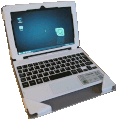Linux on a Toshiba Click Mini - Overview
Put a 64-bit Operating System on your Toshiba Click Mini, not the crippled 32-bit Windows that's supplied with it!
Not being a lover of Windows and a long term advocate of non-proprietary systems, I naturally wanted to run Linux on this device. I've concentrated on getting Linux Mint to run satisfactorily (for my purposes) due to using this distribution as my main OS for well over a decade. I continue to explore other linux distrubutions.
Like many of the 2in1 'hybrid' tablet/laptops of this era the TCM uses an Intel Atom processor on Baytrail architecture. This is an anomaly in computing terms, as the 64-bit system requires a 32-bit loader and to further confound things the TCM requires loading from a GPT style of storage.
At time of writing, there are no "out of the box" distributions that provide access to all of the hardware and various tweaks are required to get some key ones to work. (Latest distros are close.) I've created a couple of ISO distros tailored to the TCM, using Cinnamon and xfce desktop environments. Both of these can be adjusted for HiDPI displays (to some degree), as by default the text/icons/windows decoration size is tiny on the 8.9in screen.
I've found boot speed to be reasonable at around 24 seconds, from grub boot screen, to a fully usable desktop with internet connectivity.
I'll try to keep these files & information available for as long as possible but website bandwidth usage may mean I'll need to erase/move them.
The core of the project
Prebuilt ISO files are also available and as long as you can boot from a pendrive, then you can run/install Linux on your Toshiba Click Mini. I dual boot between Linux & (rarely) Windows.
Given the limited (modern) storage levels on the TCM, external media provide much more room for data, video, photos etc., so internal storage becomes less important. I use an encrypted pendrive for my data, when on holiday, for example. That leaves the (micro)SD-card slots free for storage & swap files and/or transferring from a camera or mobile phone.
For those who wish to create their own installation, perhaps using Ubuntu or some other debian based distro, I've included configuration details and appropriate (for the time) deb files.
Be aware that when applying OS/package upgrades, you should NOT allow any kernel upgrades. Other than that take any upgrade that you can get but you may have to manually re-apply patches for sound or bluetooth.
Later kernels should not be problematic but will not be tailored to this specific device.
Presented here are information and files that I've managed to pull together from various sites, plus experiments of my own. All credit goes to the original providers, whom without them, I'd never had got to this stage. There are too many to name, though an internet search should find a few. Please support the people who provide the information via donations.
By using the information and files from this website, you accept all responsibility for any possible damage caused. Use entirely at your own risk.
© ejSolutions Feb. 2018 onwards. Still being updated in 2021!
